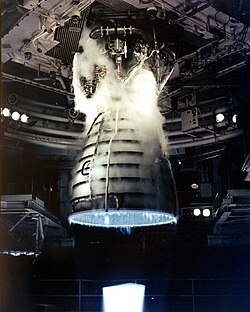Space Shuttle main engine

Space Shuttle main engine test firing
(the bright area at the bottom of the picture is a Mach disk) |
|
| Country of origin | United States |
|---|---|
| First flight | April 12, 1981 (STS-1) |
| Manufacturer | Rocketdyne |
| Associated L/V |
Space Shuttle Space Launch System |
| Predecessor | HG-3 |
| Status | Inactive since STS-135 |
| Liquid-fuel engine | |
| Propellant | Liquid oxygen / Liquid hydrogen |
| Cycle | Staged combustion |
| Configuration | |
| Nozzle ratio | 69:1 |
| Performance | |
| Thrust (vac.) | 512,300 lbf (2,279 kN) |
| Thrust (SL) | 418,000 lbf (1,860 kN) |
| Chamber pressure | 2,994 psi (20.64 MPa) |
| Isp (vac.) | 452.3 seconds (4.436 km/s) |
| Isp (SL) | 366 seconds (3.59 km/s) |
| Dimensions | |
| Length | 168 inches (4.3 m) |
| Diameter | 96 inches (2.4 m) |
| References | |
| References | |
| Notes | Data is for RS-25D at 109% throttle. |
|
|
|
|
|
|
|
|
|
|
The Aerojet Rocketdyne RS-25, otherwise known as the Space Shuttle main engine (SSME), is a liquid-fuel cryogenic rocket engine that was used on NASA's Space Shuttle and is planned to be used on its successor, the Space Launch System. Built in the United States by Rocketdyne, the RS-25 burns cryogenic liquid hydrogen and liquid oxygen propellants, with each engine producing 1,859 kN (418,000 lbf) of thrust at liftoff. Although the RS-25 can trace its heritage back to the 1960s, concerted development of the engine began in the 1970s, with the first flight, STS-1, occurring on April 12, 1981. The RS-25 has undergone several upgrades over its operational history to improve the engine's reliability, safety and maintenance load.
The engine produces a specific impulse (Isp) of 452 seconds (4.43 km/s) in a vacuum, or 366 seconds (3.59 km/s) at sea level, has a mass of approximately 3.5 tonnes (7,700 pounds), and is capable of throttling between 67% and 109% of its rated power level in one-percent increments. The RS-25 operates at temperatures ranging from −253 °C (−423 °F) to 3300 °C (6000 °F).
The Space Shuttle used a cluster of three RS-25 engines mounted in the aft structure of the orbiter, with fuel being drawn from the external tank. The engines were used for propulsion during the entirety of the spacecraft's ascent, with additional thrust being provided by two solid rocket boosters and the orbiter's two AJ10-190 orbital maneuvering system engines. Following each flight, the engines were removed from the orbiter, inspected and refurbished before being reused on another mission.
...
Wikipedia
